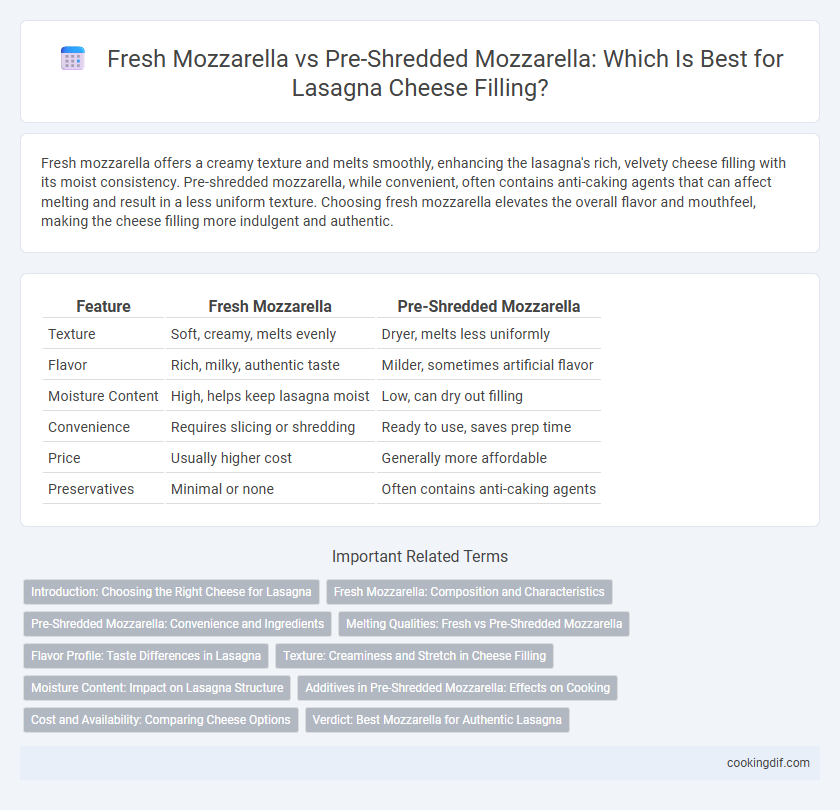Fresh mozzarella offers a creamy texture and melts smoothly, enhancing the lasagna's rich, velvety cheese filling with its moist consistency. Pre-shredded mozzarella, while convenient, often contains anti-caking agents that can affect melting and result in a less uniform texture. Choosing fresh mozzarella elevates the overall flavor and mouthfeel, making the cheese filling more indulgent and authentic.
Table of Comparison
| Feature | Fresh Mozzarella | Pre-Shredded Mozzarella |
|---|---|---|
| Texture | Soft, creamy, melts evenly | Dryer, melts less uniformly |
| Flavor | Rich, milky, authentic taste | Milder, sometimes artificial flavor |
| Moisture Content | High, helps keep lasagna moist | Low, can dry out filling |
| Convenience | Requires slicing or shredding | Ready to use, saves prep time |
| Price | Usually higher cost | Generally more affordable |
| Preservatives | Minimal or none | Often contains anti-caking agents |
Introduction: Choosing the Right Cheese for Lasagna
Fresh mozzarella offers a creamy texture and rich flavor that melts seamlessly into lasagna layers, enhancing the overall creaminess and authenticity of the dish. Pre-shredded mozzarella provides convenience and consistent melting but often contains anti-caking agents that can affect texture and moisture retention. Selecting fresh mozzarella boosts the lasagna's quality by contributing a smoother melt and fresher taste, essential for a traditional cheese filling.
Fresh Mozzarella: Composition and Characteristics
Fresh mozzarella consists of high-moisture, soft curds made from cow or buffalo milk, resulting in a tender, creamy texture ideal for lasagna cheese filling. Its delicate, milky flavor and smooth meltability create a rich and luscious layer that enhances the overall dish. Unlike pre-shredded mozzarella, fresh mozzarella has no added anti-caking agents or preservatives, ensuring pure taste and optimal melting properties.
Pre-Shredded Mozzarella: Convenience and Ingredients
Pre-shredded mozzarella offers significant convenience by eliminating the need for manual grating, saving time in the lasagna preparation process. Its blend often contains anti-caking agents like cellulose and preservatives to maintain freshness and prevent clumping. These added ingredients can slightly affect cheese meltability and texture compared to fresh mozzarella, but pre-shredded options remain a popular choice for efficient, hassle-free cooking.
Melting Qualities: Fresh vs Pre-Shredded Mozzarella
Fresh mozzarella offers superior melting qualities for lasagna, creating a creamy, gooey texture due to its higher moisture content and smoother consistency. Pre-shredded mozzarella, often treated with anti-caking agents, melts unevenly and can result in a clumpier, less smooth cheese filling. Using fresh mozzarella enhances the lasagna's overall flavor and texture by delivering a rich, velvety melt that pre-shredded versions typically cannot match.
Flavor Profile: Taste Differences in Lasagna
Fresh mozzarella offers a creamy, milky flavor that melts smoothly, enhancing the lasagna's rich texture and providing a subtle sweetness. Pre-shredded mozzarella often contains anti-caking agents, which can affect its melting quality and produce a slightly less fresh taste, resulting in a firmer, less creamy cheese layer. Choosing fresh mozzarella elevates the flavor profile of lasagna by delivering an authentic, moist, and tender cheese filling that harmonizes well with the tomato sauce and herbs.
Texture: Creaminess and Stretch in Cheese Filling
Fresh mozzarella offers a superior creamy texture and exceptional stretch in lasagna cheese fillings compared to pre-shredded mozzarella, which often contains anti-caking agents that reduce melt quality. The higher moisture content in fresh mozzarella contributes to a richer, silkier mouthfeel and a more elastic cheese pull. In contrast, pre-shredded mozzarella tends to produce a drier, less cohesive filling with diminished creaminess and stretch.
Moisture Content: Impact on Lasagna Structure
Fresh mozzarella has a higher moisture content than pre-shredded mozzarella, which significantly affects the texture and structure of lasagna. Using fresh mozzarella results in a creamier, more cohesive cheese filling, while pre-shredded mozzarella's lower moisture helps prevent excess water release, maintaining distinct layers. Balancing moisture levels is crucial to avoid soggy lasagna or a dry, crumbly filling.
Additives in Pre-Shredded Mozzarella: Effects on Cooking
Fresh mozzarella offers a creamy texture and melts evenly in lasagna, whereas pre-shredded mozzarella often contains additives like anti-caking agents and preservatives that can affect melt quality and moisture release. These additives sometimes cause pre-shredded cheese to be drier and less cohesive during baking, leading to a less smooth cheese filling. Choosing fresh mozzarella ensures a richer texture and better flavor integration in the lasagna's layers.
Cost and Availability: Comparing Cheese Options
Fresh mozzarella offers superior creaminess and melt quality but tends to be more expensive and less widely available than pre-shredded mozzarella, which provides convenience and longer shelf life. Pre-shredded mozzarella is often found in standard grocery stores at a lower price point, making it a budget-friendly option for frequent lasagna preparation. Choosing between the two depends on balancing cost-efficiency with the desired texture and flavor of the cheese filling.
Verdict: Best Mozzarella for Authentic Lasagna
Fresh mozzarella delivers a creamy texture and rich flavor that melts beautifully, making it the top choice for authentic lasagna cheese filling. Pre-shredded mozzarella often contains anti-caking agents that can hinder smooth melting and alter the dish's consistency. For a traditional, luscious lasagna experience, fresh mozzarella outperforms pre-shredded varieties in both taste and melt quality.
Fresh mozzarella vs pre-shredded mozzarella for cheese filling Infographic

 cookingdif.com
cookingdif.com